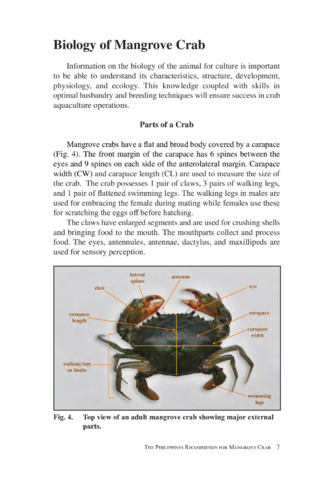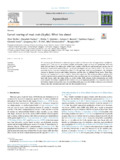Commercial evaluation of monosex pond culture of the mud crab Scylla species at three stocking densities in the Philippines.
| dc.contributor.author | Triño, Avelino T. | |
| dc.contributor.author | Millamena, Oseni M. | |
| dc.contributor.author | Keenan, C. | |
| dc.date.accessioned | 2013-12-17T09:07:10Z | |
| dc.date.available | 2013-12-17T09:07:10Z | |
| dc.date.issued | 1999 | |
| dc.identifier.citation | Triño, A. T., Millamena, O. M., & Keenan, C. (1999). Commercial evaluation of monosex pond culture of the mud crab Scylla species at three stocking densities in the Philippines. Aquaculture, 174(1–2), 109–118. | en |
| dc.identifier.issn | 0044-8486 | |
| dc.identifier.uri | http://hdl.handle.net/10862/1852 | |
| dc.description.abstract | The effects of three levels of stocking density (0.5, 1.5 or 3.0 m−2) and monosex culture (male or female) on the growth, apparent feed conversion ratio (FCR), survival, and production of mixed species of mud crabs, Scylla serrata and S. tranquebarica, were investigated. The juvenile crabs were stocked in 150 m2 earthen ponds with Gracilariopsis bailinae as shelter and fed a mixed diet of 75% fresh mussel flesh and 25% fish bycatch. There was no interaction between stocking density levels and monosex culture (P<0.05) so that data were pooled for each sex or stocking density treatment. Highest survival and the most efficient FCR were obtained from stocking density of 0.5 m−2 (P<0.05). Crab growth rates in different stocking densities were not significantly different (P>0.05). Male crabs attained significantly higher (P<0.05) final weight and specific growth rate (SGR) than female crabs. However, final crab length, width, FCR, survival, and production were not significantly different between male and female crabs (P>0.05). Highest return on investment (ROI) and lowest production cost were obtained from 0.5 m−2. Partial budgeting analysis showed that no net benefit accrued from stocking beyond 1.5 m−2. Both male or female monosex cultures gave high net revenue and ROI of more than 100%. Results suggest that the culture of male or female mud crabs at 0.5–1.5 m−2 is economically viable but male monosex culture is more profitable. | en |
| dc.description.sponsorship | The study was funded by SEAFDEC/AQD and ACIAR under Project No. 9217. | en |
| dc.language.iso | en | en |
| dc.publisher | Elsevier | en |
| dc.subject | Scylla serrata | en |
| dc.subject | Scylla tranquebarica | en |
| dc.subject | FCR | en |
| dc.subject | Mud crab | en |
| dc.title | Commercial evaluation of monosex pond culture of the mud crab Scylla species at three stocking densities in the Philippines. | en |
| dc.type | Article | en |
| dc.identifier.doi | 10.1016/S0044-8486(99)00002-2 | |
| dc.citation.volume | 174 | |
| dc.citation.issue | 1-2 | |
| dc.citation.spage | 109 | |
| dc.citation.epage | 118 | |
| dc.citation.journalTitle | Aquaculture | en |
| seafdecaqd.library.callnumber | VF SJ 0624 | |
| seafdecaqd.databank.controlnumber | 1999-04 | |
| dc.subject.asfa | aquaculture development | en |
| dc.subject.asfa | crab culture | en |
| dc.subject.asfa | monosex culture | en |
| dc.subject.asfa | production | en |
| dc.subject.asfa | pond culture | en |
| dc.subject.asfa | survival | en |
| dc.subject.asfa | growth | en |
| dc.subject.asfa | economics | en |
| dc.subject.scientificName | Scylla serrata | en |
Files in this item
| Files | Size | Format | View |
|---|---|---|---|
|
There are no files associated with this item. |
|||
This item appears in the following Collection(s)
-
Journal Articles [1229]
These papers were contributed by Department staff to various national and international journals.




